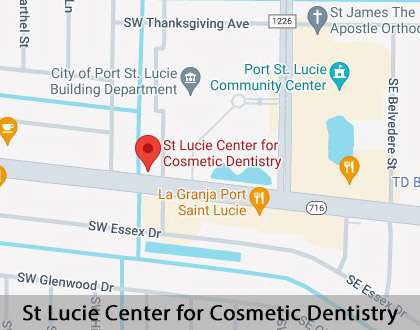Gum Disease Port St. Lucie, FL
Gum disease is a serious condition that can infect the gums, destroying the jaw and underlying bone. There are many ways to prevent gum disease and various treatment options for patients who acquire it. Effective and successful gum disease treatment involves detection in the early stages before any severe damage to the gums, bone, or jaw can occur.
Gum disease treatment is available at St Lucie Center for Cosmetic Dentistry in Port St. Lucie and the surrounding area. We can help diagnose and treat gum disease while providing patients with tips on how to maintain a healthy oral cavity. Call us today at (772) 242-4124 to schedule an appointment or learn more about our services.
Understanding Gum Disease
According to the American Dental Association, gum disease is an infection of the tissues surrounding and supporting the teeth. Gum disease, also known as periodontal disease, is not always accompanied by pain—meaning that patients may not even know that they have it.
Usually, gum disease is caused by a poor oral hygiene routine that allows an excess of plaque (a sticky film of bacteria) to build up on the teeth. When plaque hardens under the gumline into tartar, it becomes more difficult to remove. At this point, the patient will be unable to remove the plaque and tartar without professional dental cleaning.
“Gum disease, also known as periodontal disease or periodontitis, is not always accompanied by pain—meaning that patients may not even know that they have it.”
Preventing Gum Disease
Most cases of gum disease are caused by poor oral hygiene. Unsurprisingly, maintaining a good oral hygiene routine is one of the first lines of defense in protecting oneself against gum disease. Patients should brush their teeth for two minutes at least twice a day and floss at least once a day. Flossing before brushing is imperative, as this allows the patient to clean away any loosened food particles and bacteria. Routine dental visits are also key in preventing gum disease, especially for patients already at risk of developing gum disease. These patients include those who smoke, take certain medications, or suffer from dry mouth. Ideally, patients should have their teeth professionally cleaned every six to 12 months.
“Most cases of gum disease are caused by poor oral hygiene.”
Common Signs of Gum Disease
Gum disease is an advanced condition that is usually diagnosed early when a patient exhibits signs of gingivitis. However, patients may not experience pain or noticeable symptoms. Thus, without regular dental visits, the patient may not realize they have gum disease. Healthy gums are light pink and hug the teeth snugly, whereas unhealthy gums are typically discolored and soft. This is often the first sign a dentist or a patient themself may notice.
The American Dental Association lists the common signs that signal a patient may have gum disease:
- Gums that bleed easily
- Red, swollen, tender gums
- Gums that have pulled away from the teeth
- Persistent bad breath or bad taste
- Permanent teeth that are loose or separating
- Any change in the way the teeth fit together when the bite is closed
- Any change in the fit of partial dentures
“Healthy gums are light pink and hug the teeth snugly, whereas unhealthy gums are typically discolored and soft.”
Check out what others are saying about our dental services on Yelp: Gum Disease in Port St. Lucie, FL
Treating Gum Disease
The earlier signs of gum disease are detected, the less invasive treatment procedures are. These may include antibiotics, root planing, and scaling. Antibiotics can help control infection and can be administered either topically or orally. Root scaling and planing are often performed together. While root planing smoothes the root surfaces to remove bacteria and discourage further buildup, root scaling removes tartar and bacteria from the tooth surfaces and beneath the gums.
More advanced gum disease may require more invasive solutions, such as oral surgery. Treatments may involve bone grafting, guided tissue regeneration, pocket reduction surgery (also known as flap surgery), soft tissue grafts, and tissue-stimulating proteins. Bone grafting and guided tissue regeneration may help promote bone regeneration. Pocket reduction surgery may allow for more effective root scaling and planing, while soft tissue grafts may reinforce damaged soft tissue. Finally, tissue-stimulating proteins may help stimulate the growth of healthy bone and tissue.
“The earlier signs of gum disease are detected, the less invasive treatment procedures are.”
Questions Answered on This Page
Q. How can I prevent gum disease?
Q. How can I treat gum disease?
Q. What are common signs of gum disease?
People Also Ask
Q. What lifestyle factors can trigger gum bleeding?
Q. What are the benefits of gum contouring?
Q. What are signs of oral cancer?
Q. Where can I learn more about my dental diagnosis and treatment?
Q. What family members may need extra help with their oral hygiene?
Gum Disease Statistics
According to the Centers for Disease Control and Prevention (CDC), almost half of all adults in the United States have some form of periodontal disease. This number increases with age, with 70% of adults 65 years and older reporting to have the condition. Furthermore, it is more common among men than women. To address such problems, the CDC is working with organizations like the American Academy of Periodontology and the American Dental Association to "improve and sustain surveillance of periodontal disease in the adult U.S. population."
“According to the Center for Disease Control and Prevention (CDC), almost half of all American adults suffer from some form of periodontal disease.”
Frequently Asked Questions
Q. Is gum disease curable?
A. Gum disease is reversible in mild to moderate cases in which the infection has not caused severe side effects, such as tooth loss. Periodontal disease, the advanced stage of gum disease, is not reversible. It is important to undergo treatment immediately after a diagnosis to prevent further progression of the disease.
Q. What is the link between gum disease and cardiovascular disease?
A. The mouth is one of the main entryways to the rest of the body and any bacteria, good or bad, travels through the airways to the respiratory system. Plaque is an extremely harmful bacteria that can clog arteries and the heart valves, causing cardiovascular problems.
Q. How can I treat gum disease at home?
A. There are many at-home treatments for gum disease today, including special tools and mouthwashes that help strengthen the gums and remove plaque. However, no at-home treatment trumps professional dental cleanings. We use medical-grade tools made especially for the teeth and gums and have the necessary training to combat oral disease and infection. Even a simple routine dental cleaning can reduce or eliminate gum disease by clearing the pockets and minimizing depths.
Q. How much does gum flap surgery cost?
A. Flap surgery, also called surgical pocket reduction, is considered a minor surgery. The surgery typically costs between $1,000 to $3,000 for patients paying out-of-pocket. Most insurance plans cover gum disease treatment as it is a severe condition that can put a patient's oral health at risk. We encourage patients to talk to their insurance provider to fully understand what their plan entails.
Q. What if gum disease is left untreated?
A. When gum disease goes untreated, the infection inevitably spreads and destroys more of the gums, underlying bone, and jaw. That is why loose teeth and tooth loss are common complications of the disease. Gum disease can also result in cardiovascular and respiratory issues as plaque travels through the mouth to the airways and valves within our other body systems.
Gum Disease Terminology
Learn More Today
Gum disease may lead to worse oral health problems further along the line. We at St Lucie Center for Cosmetic Dentistry may be able to help. Call us today at (772) 242-4124 to schedule an appointment and learn more.
Helpful Related Links
- American Dental Association (ADA). Glossary of Dental Clinical Terms. 2024
- American Academy of Cosmetic Dentistry® (AACD). Home Page. 2024
- WebMD. WebMD’s Oral Care Guide. 2024
About our business and website security
- St Lucie Center for Cosmetic Dentistry was established in 1984.
- We accept the following payment methods: American Express, Cash, Check, Discover, MasterCard, and Visa
- We serve patients from the following counties: St. Lucie County
- We serve patients from the following cities: Port St. Lucie, River Park, White City, Fort Pierce, Fort Pierce South, St Lucie West, Tradition, Palm City, Jensen Beach, and Stuart
- Norton Safe Web. View Details
- Trend Micro Site Safety Center. View Details
Back to top of Gum Disease














